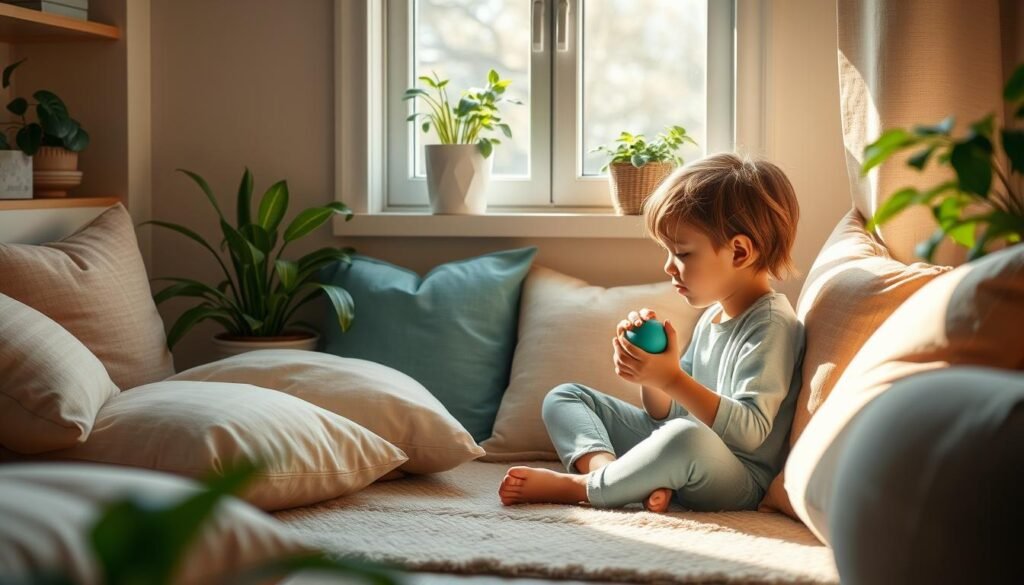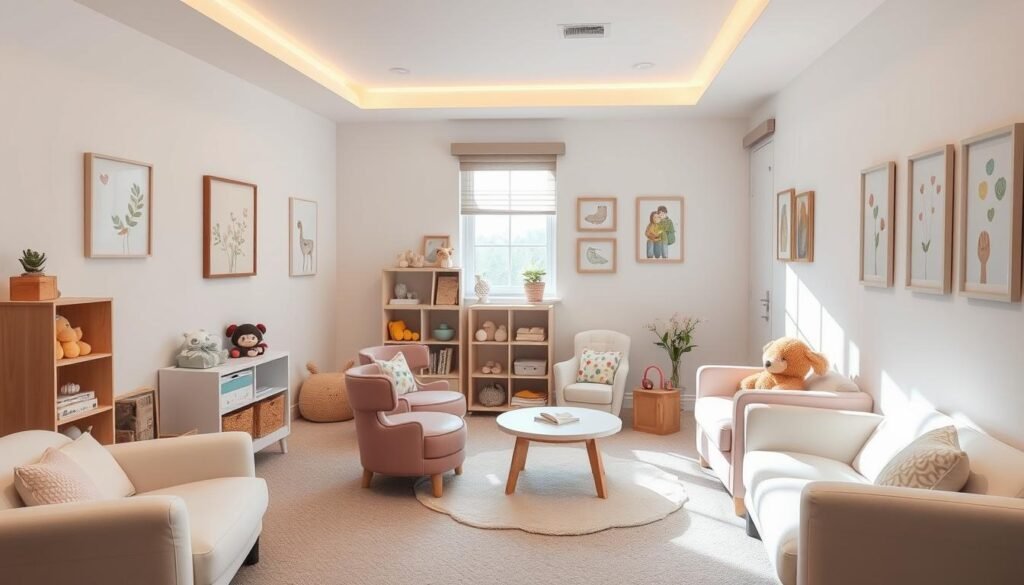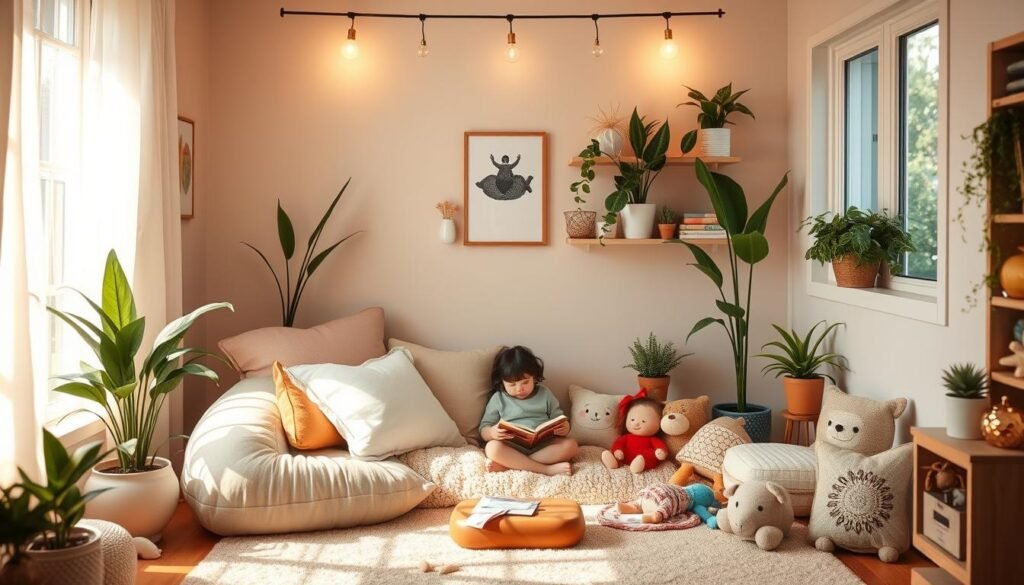Nearly 1 in 3 children in the United States will face an anxiety disorder by 18. This fact highlights how common anxiety is during childhood. It shows why parents and caregivers need to take action. Knowing how to help a child with anxiety is key for their happiness and for teaching them to handle tough times. While it’s natural to want to shield kids from stress, being too protective can actually make anxiety worse. By learning the best ways to support anxious kids, parents can help them tackle fears, grow confident, and succeed.
Key Takeaways
- Around 30% of children will encounter an anxiety disorder by age 18.
- Overprotective parenting can worsen anxiety instead of alleviating it.
- Encouraging children to face their fears fosters resilience.
- Validating feelings while promoting confidence is essential.
- Open-ended questions about emotions facilitate effective reflection.
- Unique triggers and coping methods are vital to understanding anxiety.
Understanding Childhood Anxiety Disorders
Anxiety disorders in kids are more common than we think. They affect many children in different ways. Kids can face generalized anxiety disorder, separation anxiety, social anxiety, and more. These issues make everyday tasks hard.
Anxiety looks different in young kids than in older ones. Very young children might get clingy, throw tantrums, or fear saying goodbye. Older kids may avoid certain situations or become irritable. It’s important to know these signs to help them.
IDENTIFYING THE TRIGGERS
Things like school stress, social challenges, and big changes in the family can cause anxiety. Parents need to watch for these triggers. Spotting them early helps manage anxiety better.
Acting early is key. Treatments like Cognitive Behavioral Therapy (CBT) and medicines known as SSRIs work well. Using both treatments together is often best. This mix meets the child’s needs fully.
| Treatment Method | Effectiveness | Notes |
|---|---|---|
| Cognitive Behavioral Therapy (CBT) | Effective | Focuses on changing negative thought patterns and behaviors. |
| Selective Serotonin Reuptake Inhibitors (SSRIs) | Effective | Medications that help balance serotonin levels in the brain. |
| Combined Approach | Most Effective | Combining CBT and SSRIs often leads to improved outcomes. |
Talking more openly about anxiety helps identify and support kids better. While some kids might overcome anxiety as they grow, addressing it directly is crucial. For more info on supporting kids with anxiety, click here.
Knowing about childhood anxiety and acting early can really help a child’s future happiness and coping skills.
Signs of Anxiety in Children
It’s very important to spot anxiety signs in kids early. They show symptoms in both their bodies and emotions. This helps them get the support they need quickly.
Physical signs may include:
- Complaints of stomach aches or headaches
- Increased heart rate or sweating
- Tensing of muscles
Emotional responses might involve:
- Heightened fearfulness
- Irritability or mood swings
- Feelings of hopelessness
Behavioral changes are also common indicators. Children may:
- Withdrawal from social situations
- Avoid certain activities or places
- Show reluctance to attend school
Specific anxiety disorders can present unique symptoms, such as:
| Anxiety Disorder | Signs |
|---|---|
| Separation Anxiety Disorder | Symptoms persist for at least four weeks, often including distress about leaving caregivers. |
| Social Anxiety Disorder | Extreme self-consciousness that disrupts daily life. |
| Generalized Anxiety Disorder | Excessive worry experienced most days for at least six months. |
| Panic Disorder | At least one panic attack along with other related signs. |
| Obsessive-Compulsive Disorder (OCD) | Presence of obsessions, compulsions, or both. |
| Specific Phobia | Avoidance behavior regarding specific feared objects or situations. |
Parents have a key role in supporting anxious kids. Recognizing these signs early helps react effectively. Knowing these signs means parents can find the right help, like therapy.
How to Support a Child with Anxiety
Kids show anxiety in different ways, and it’s key to see how it affects them. Understanding their anxious feelings helps us meet their emotional needs right. Knowing that one out of five kids will face serious anxiety by their teens stresses the need for early help.
The Importance of Recognition
When we listen to a child’s worries without judging, they feel safe to share their fears. It’s important for parents to talk openly about emotions, making sure kids are heard and understood. Anxiety signs can be a fast heartbeat, crying, or saying their stomach hurts.
Knowing these signs come from anxiety helps parents support their child better.
Common Triggers and Stressors
Anxiety in children often links to certain events or big changes. Some common triggers are:
- School stress
- Family fights
- Seeing violence or living in poverty
- Big changes like moving or parents divorcing
Anxiety usually starts around age 11, but it can start much sooner. Young kids between 3 to 5 often feel separation anxiety, which might come back around 8 or 9. This shows there might be a deeper issue.
Understanding these triggers helps parents support their children’s emotional needs. Keeping an open talk helps kids deal with anxiety challenges. This way, they feel less alone and can bravely face their fears.
| Statistics on Anxiety Disorders in Children | Details |
|---|---|
| Children with Anxiety Disorders | More than 9% of children |
| Adolescents with Anxiety Disorders | 32% of adolescents experience anxiety |
| Genetic Risk Factor | One-third to half of the risk is genetic |
| Common age for Diagnosis | 4 to 8 years old |
| Underdiagnosis and Undertreatment | Anxiety often goes undetected |
Creating a Safe Environment for Anxious Children
Creating a safe space for kids with anxiety is crucial for their happiness and growth. By keeping open lines of communication and ensuring emotional safety, parents can create a supportive home. This environment lets kids share their fears safely and freely.
Encouraging Open Communication
Talking openly is key when raising anxious kids. Daily chats can help kids express their feelings and worries. It’s important for parents to listen without judgment, making kids feel safe to open up about their fears.
- Set aside daily time for conversations.
- Encourage children to share their worries.
- Praise them for expressing their feelings.
Asking questions that prompt discussion can deepen understanding and connection. Parents should inquire about their kid’s day, their emotions, or any specific fears, showing it’s okay to discuss anxiety.
Building Emotional Safety
Emotional safety is as crucial as open talks. Validating a child’s feelings and promoting emotional expression can make them feel understood and accepted. This reduces their sense of isolation and anxiety.
- Model calm behavior during stressful moments.
- Teach relaxation techniques to manage anxiety.
- Establish predictable routines to provide stability.
These actions greatly support children’s ability to cope and bounce back. A nurturing environment promotes emotional health, bringing positivity and steadiness into the lives of anxious children.
| Activity | Benefit |
|---|---|
| Daily Conversations | Encourages expression of feelings |
| Modeling Calm Behavior | Reduces children’s anxiety levels |
| Establishing Routines | Provides predictability and stability |
| Relaxation Techniques | Aids in managing stress and anxiety |
Empowering Your Child with Coping Strategies
Teaching kids how to cope with anxiety is very important. It helps them understand their feelings better and become emotionally strong. They learn to deal with stress and worry. This way, they gain skills that are useful for their whole life.
Developing Deep Breathing Techniques
Deep breathing is a great way to manage anxiety in kids. It teaches them to control their breath. This triggers their body to relax, easing anxiety signs. A simple practice involves inhaling for four counts, holding the breath for four, then exhaling for four. Doing this regularly really helps.
Utilizing Grounding Exercises
Grounding exercises can help a child stop worrying so much. You can ask them to note five things they see, four they touch, three they hear, two they smell, and one they taste. This helps them live in the moment and know themselves better emotionally.
Encouraging Journaling and Visualization
Journaling lets kids write down what worries them, which is good for their emotional growth. Imagining calm places can also help them relax more. Using these techniques every day can help kids understand and deal with their emotions better. For more ways to help, check out this resource.
| Technique | Benefit | Implementation |
|---|---|---|
| Deep Breathing | Regulates the body’s stress response | Practice regularly; use calming visuals |
| Grounding Exercises | Redirects focus in anxiety-inducing situations | Incorporate sensory identification |
| Journaling | Encourages emotional expression and intelligence | Daily reflections on feelings and experiences |
| Visualization | Creates mental calmness and positive imagery | Encourage vivid imagery of peaceful scenarios |
Using these methods helps kids manage anxiety well, which is good for their happiness and success in the future. Teaching children these coping skills helps them handle anxiety better as they get older.
Effective Anxiety Management for Kids
To manage anxiety well, we need to find a balance. It helps to give kids the right tools. It’s key not to be too protective. This way, they can face their fears and get stronger.
Avoiding Overprotection
Sometimes, parents try to keep their kids from tough situations. But this might make their anxiety worse. It’s better to let them face small challenges. This teaches them how to deal with their feelings.
We should encourage them to tackle their fears bit by bit. This helps them learn and grow. They need our support but also need to try things on their own.
Facing Fears Gradually
Step-by-step exposure to what scares them can be really effective. This method slowly builds up their confidence. For instance, if a child fears dogs, start with pictures, then watch a dog from afar, and finally, get closer.
Setting routines and learning how to relax are key. Kids should also feel okay asking for help. These steps are crucial in overcoming anxiety. They boost self-esteem and show that facing fears helps us grow. Visit the CDC for more info.

| Age Range | Common Anxieties | Recommended Strategies |
|---|---|---|
| 6 months to 3 years | Separation anxiety | Gradual separation exercises |
| Preschool age | Fears of animals, darkness, storms | Storytelling to normalize fear |
| Adolescents | Social anxiety, avoidance of gatherings | Encouragement to participate in social activities |
| Teenagers | Test anxiety, fear of failure | Study groups and time management techniques |
Supporting Anxious Children at School
Helping anxious kids in school demands teamwork between parents and teachers. Understanding that each kid’s anxiety has different causes is key. Kids might struggle in making friends or with schoolwork and teacher relationships.
Parents should encourage kids to talk about their feelings freely. This helps tackle anxiety head-on, helping kids face their fears. A network of support, showing faith in a child’s ability to handle anxiety, is beneficial.
Using tools like the “anxiety iceberg” or mind maps reveals the root of school anxiety. By collaborating with schools, parents can address these issues. They might suggest meeting with teachers and asking for helpful changes, such as visual schedules or safe break areas.
Celebrating every small win boosts a kid’s self-confidence and aids in anxiety management. Feeling recognized makes kids more willing to deal with school problems bravely. This supportive method is crucial for reducing stress in tough school times.
Involving Professionals in Childhood Anxiety Treatment
Getting help from mental health experts is crucial for kids with severe anxiety. It’s important for parents to know when to get help. Signs to look out for include constant worry, trouble focusing, being easily annoyed, or acting differently. Getting help early is important to support the child.
The first step is to see a General Practitioner (GP). The GP can send the child to get a full check-up at the children and young people’s mental health services (CYPMHS). There are many treatments that can help. These include talking to a therapist, cognitive-behavioral therapy (CBT), and medicine. The treatment chosen depends on the child’s age and what causes their anxiety.
Cognitive-behavioral therapy works well for anxiety and usually takes about 12 weeks. It can help a lot over time. Studies show that using CBT and medicine together works better than using one alone. Medicines called SSRIs are approved for kids with anxiety. They are especially used for obsessive-compulsive disorder in kids.
While many medicines might not work well and can be risky, fluoxetine is an exception. Doctors watch children closely when giving them these medicines. This is to check for any bad effects. Some common side effects are headaches, stomachaches, and trouble sleeping.
It’s very important to handle anxiety treatment in kids right. Anxiety can make school and home life hard. Working together, parents, GPs, and experts can give the child the care they need. This helps them face and beat anxiety.

Building Resilience in Anxious Kids
It’s important to help anxious kids become stronger in facing their fears. Parents are key in teaching them how to deal with tough times. They do this by showing how to handle emotions well and by having realistic expectations for their kids’ growth.
Modeling Healthy Emotional Responses
Kids watch their parents for cues on how to act, especially when things get tough. If parents stay calm during stress, their children learn to do the same. This teaches kids how to be strong when they’re anxious.
Talking about feelings is also important. It helps kids to talk about their worries too. This makes them feel safe to share and builds trust.
Setting Realistic Expectations
It’s important not to push kids too hard. Understanding that it takes time to overcome fears helps kids to not feel too stressed. Setting goals they can actually achieve helps build their confidence.
This approach also teaches kids to see the bright side of their struggles. They learn to be patient as they get better at handling their emotions.
Practical Tips for Parenting Anxious Children
Parenting anxious children needs a careful approach. It’s about making them feel safe. Practical tips for parenting anxious children can make a big difference. It helps both the child and the parent handle anxiety better. A regular routine is key. It gives children a sense of safety and something they can count on. Reducing uncertainty in their daily lives can lower anxiety.
Talking openly is critical. Listen to your child’s worries without being quick to judge. This kind of support makes them feel understood and builds trust. It’s okay for them to feel anxious. Let them know that. This will help them face their fears. Teaching them to breathe deeply or be mindful are good ways to help. These anxiety management strategies for kids help them calm down when stressed.
Using positive feedback helps too. Cheer them on as they face their fears, even in small steps. This builds their courage and keeps them going. Don’t be too protective. This could actually make their anxiety worse. Instead, help them face their fears bit by bit. This way, they learn to deal with challenges better.
Limiting screen time is also important. Too much screen time can make anxiety worse. This is especially true if they see upsetting things online. Encourage them to play outside or spend time with the family instead. This can help them focus less on what makes them anxious.
Last but not least, working with experts can improve these practical tips for parenting anxious children. Therapy, like Cognitive Behavioral Therapy (CBT), can really help reduce anxiety. Using these strategies together lays a strong foundation. It helps children manage anxiety better, leading to healthier emotional lives.

| Parenting Strategy | Description |
|---|---|
| Establish Routines | Creates stability and predictability in daily life. |
| Open Communication | Encourages children to express their feelings without fear of judgment. |
| Positive Reinforcement | Praises efforts with gradual exposure to fears, building confidence. |
| Mindfulness Techniques | Utilizes deep breathing and relaxation strategies for anxiety management. |
| Monitor Digital Media | Regulates screen time to prevent anxiety exacerbation from harmful content. |
| Professional Support | Includes therapy options such as CBT for effective anxiety treatment. |
Conclusion
It’s vital to understand childhood anxiety to support kids better. Up to 30% of kids might feel anxious. Knowing this early is key. Helping an anxious child requires creating a safe, nurturing environment. This means talking openly, having routines, and spending quality time together.
How parents act can affect a child’s anxiety. Being too protective might stop them from learning to cope. If anxiety lasts more than six months, professional help is a good idea. Web resources, like understanding childhood anxiety symptoms, offer helpful tips for parents.
Dealing with anxious children demands consistency and care. By being supportive, parents lay the groundwork for their kids’ mental health. Coping methods like physical exercise and focusing on senses can reduce anxiety. Taking steps to help anxious children can make a big difference in their happiness.